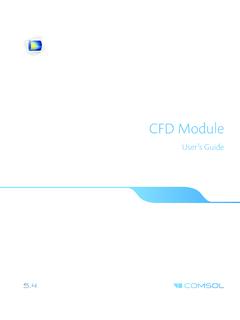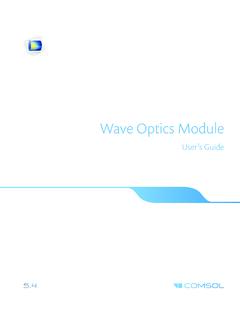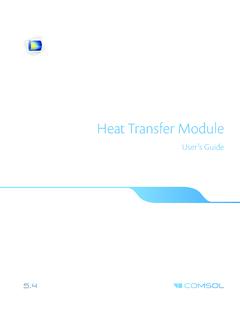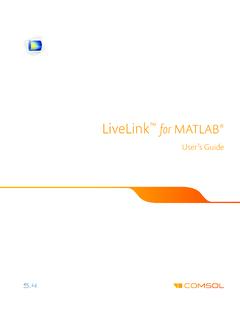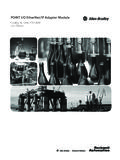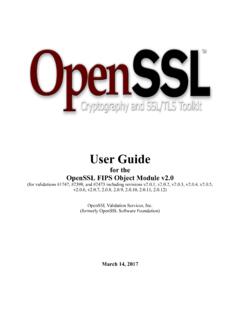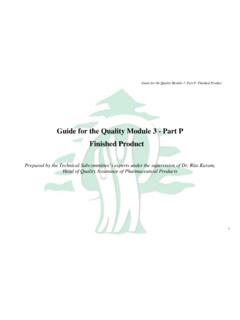Transcription of The Particle Tracing Module User’s Guide
1 Particle Tracing ModuleUser s GuideContact InformationVisit the Contact COMSOL page at to submit general inquiries, contact Technical Support, or search for an address and phone number. You can also visit the Worldwide Sales Offices page at for address and contact you need to contact Support, an online request form is located at the COMSOL Access page at Other useful links include: Support Center: Product Download: Product Updates: COMSOL Blog: Discussion Forum: Events: COMSOL Video Gallery: Support Knowledge Base: number: CM022701 Particle Tracing Module user s Guide 1998 2018 COMSOLP rotected by patents listed on , and Patents 7,519,518; 7,596,474; 7,623,991; 8,457,932; 8,954,302; 9,098,106; 9,146,652; 9,323,503; 9,372,673; and 9,454,625. Patents Documentation and the Programs described herein are furnished under the COMSOL Software License Agreement ( ) and may be used or copied only under the terms of the license , the COMSOL logo, COMSOL Multiphysics, COMSOL Desktop, COMSOL Server, and LiveLink are either registered trademarks or trademarks of COMSOL AB.
2 All other trademarks are the property of their respective owners, and COMSOL AB and its subsidiaries and products are not affiliated with, endorsed by, sponsored by, or supported by those trademark owners. For a list of such trademark owners, see : COMSOL | 3 Contents Chapter 1: IntroductionAbout the Particle Tracing Module 10 What Can the Particle Tracing Module Do?.. 10 Particle Tracing Plots, Data Sets, Derived Values, and Studies .. 11 The env and bndenv Operators .. 12 The Particle Tracing Module Physics Interface Guide .. 13 Common Physics Interface and Feature Settings and Nodes .. 14 Where Do I Access the Documentation and Application Libraries? .. 15 Overview of the user s Guide 19 Chapter 2: Particle Tracing ModelingParticle Tracing 22 Introduction to Particle Tracing Modeling .. 22 Charged Particle Tracing .. 23 Particle Tracing for Fluid Flow.
3 25 Mathematical Particle Tracing .. 31 Multiphysics Couplings.. 31 Modeling Tools 33 Choosing a Formulation .. 33 Geometry and Mesh Settings .. 37 Special Variables .. 40 Component Couplings.. 44 Monte Carlo Modeling.. 46 Study Setup .. 47 Auxiliary Dependent Variables and Residence Time .. 50 Initialization of Auxiliary Dependent Variables .. 51 Accumulators .. 53 Particle Tracing with Multiple Species .. 544 | CONTENTSF ilters .. 56 Particle Counters.. 57 Improving Plot Quality.. 58 References .. 60 Chapter 3: Mathematical Particle TracingThe Mathematical Particle Tracing Interface 62 Domain, Boundary, Pair, and Global Nodes for the Mathematical Particle Tracing Interface .. 68 Wall .. 70 Thermal Re-Emission .. 74 Periodic Condition .. 74 Accumulator (Boundary) .. 76 Particle Counter .. 77 Secondary Emission .. 78 Particle Properties.
4 81 Force .. 83 Rotating Frame .. 84 Velocity Reinitialization .. 85 Accumulator (for Velocity Reinitialization) .. 87 Accumulator (Domain) .. 88 Particle - Particle Interaction .. 89 Release .. 92 Axial Symmetry .. 99 Inlet .. 99 Nonlocal Accumulator.. 104 Outlet .. 105 Particle Continuity .. 106 Auxiliary Dependent Variable .. 106 Release from Edge .. 107 Release from Point .. 107 Release from Grid .. 108 Release from Data File.. 110 CONTENTS | 5 Theory for the Mathematical Particle Tracing Interface 113 Newtonian Formulation .. 113 Hamiltonian Formulation .. 115 Lagrangian Formulation .. 115 Massless Formulation .. 116 Particle Tracing in Rotating Frames .. 116 Initial Conditions: Position .. 117 Initial Conditions: Velocity .. 117 Particle - Particle Interactions .. 120 Auxiliary Dependent Variables.
5 122 About the Boundary Conditions for the Particle Tracing Interfaces .. 123 Accumulator Theory: Domains .. 126 Accumulator Theory: Boundaries .. 127 Accumulator Theory: Velocity Reinitialization .. 129 References for the Mathematical Particle Tracing Interface .. 130 Chapter 4: Charged Particle TracingThe Charged Particle Tracing Interface 132 Domain, Boundary, Pair, and Global Nodes for the Charged Particle Tracing Interface .. 135 Collisions.. 137 Elastic .. 139 Excitation .. 141 Attachment .. 141 Ionization.. 142 Resonant Charge Exchange .. 143 Nonresonant Charge Exchange .. 143 user Defined .. 144 Friction Force .. 146 Particle -Matter Interactions .. 147 Ionization Loss.. 148 Nuclear Stopping .. 149 Particle Beam .. 149 Thermionic Emission .. 160 Particle Properties.
6 1626 | CONTENTSS ymmetry .. 163 Electric Force .. 163 Magnetic Force .. 165 Space Charge Density Calculation .. 169 Surface Charge Density .. 170 Current Density .. 170 Heat Source .. 171 Etch .. 171 Theory for the Charged Particle Tracing Interface 172 Introduction to the Charged Particle Tracing Interface Theory .. 172 Electric Force Theory .. 174 Magnetic Force Theory .. 174 Collisional Force Theory .. 175 Particle -Matter Interaction Theory .. 185 Particle Beam Theory .. 188 Thermionic Emission Theory .. 193 Specialized Boundary Accumulators .. 198 References for the Charged Particle Tracing Interface .. 202 Chapter 5: Particle Tracing for Fluid FlowThe Particle Tracing for Fluid Flow Interface 204 Domain, Boundary, Pair, and Global Nodes for the Particle Tracing for Fluid Flow Interface.
7 208 Particle Properties .. 210 Symmetry .. 211 Drag Force .. 211 Lift Force .. 215 Brownian Force .. 216 Gravity Force .. 218 Acoustophoretic Force .. 219 Electric Force .. 220 Magnetic Force .. 221 Dielectrophoretic Force .. 221 Shell.. 223 CONTENTS | 7 Magnetophoretic Force .. 224 Thermophoretic Force .. 225 Erosion .. 227 Mass Deposition .. 228 Boundary Load .. 229 Mass Flux.. 229 Volume Force Calculation .. 229 Convective Heat Losses .. 231 Radiative Heat Losses .. 231 Heat Source .. 232 Droplet Breakup .. 232 Kelvin-Helmholtz Breakup Model .. 233 Rayleigh-Taylor Breakup Model .. 233 Nozzle .. 234 Nozzle Domain .. 236 The Droplet Sprays in Fluid Flow Interface 238 Theory for the Particle Tracing for Fluid Flow Interface 239 Particle Motion in a Fluid.
8 239 Particle Motion in a Turbulent Flow.. 246 Particle Motion in a Shear Flow .. 254 Additional Forces.. 258 Erosion Theory .. 267 Droplet Breakup Theory .. 269 Nozzle Theory .. 273 Computing Particle Temperature.. 275 Computing Particle Mass .. 277 References for the Particle Tracing for Fluid Flow Interface .. 277 Chapter 6: Multiphysics InterfacesThe Particle Field Interaction, Non-Relativistic Interface 282 Electric Particle Field Interaction .. 284 Space Charge Limited Emission .. 2868 | CONTENTST heory for the Particle Field Interaction, Non-Relativistic Interface 288 Electrostatics and Charged Particle Tracing Equations .. 288 Space Charge Density Calculation.
9 289 Stabilization of the Space Charge Density Calculation .. 293 Theory for the Space Charge Limited Emission Node .. 294 The Particle Field Interaction, Relativistic Interface 298 Magnetic Particle Field Interaction .. 301 Theory for the Magnetic Particle Field Interaction, Relativistic Interface 303 Electrostatics and Charged Particle Tracing Equations .. 303 Current Density Calculation .. 305 The Fluid- Particle Interaction Interface 309 Fluid- Particle Interaction .. 311 Theory for the Fluid- Particle Interaction Interface 313 Laminar Flow and Particle Tracing Equations .. 313 Volume Force Calculation .. 314 Chapter 7: GlossaryGlossary of Terms 320 9 1 IntroductionThis Guide describes the Particle Tracing Module , an optional add-on package for COMSOL Multiphysics designed to compute Particle trajectories.
10 The particles can interact with boundaries and their motion can be affected by external fields, which may be user -defined or solved for by other physics chapter introduces you to the capabilities of this Module . A summary of the physics interfaces and where you can find documentation and model examples is also included. The last section is a brief overview with links to each chapter in this this chapter: About the Particle Tracing Module Overview of the user s Guide10 | CHAPTER 1: INTRODUCTIONA bout the Particle Tracing ModuleThese topics are included in this section: What Can the Particle Tracing Module Do? Particle Tracing Plots, Data Sets, Derived Values, and Studies The env and bndenv Operators The Particle Tracing Module Physics Interface Guide Where Do I Access the Documentation and Application Libraries?What Can the Particle Tracing Module Do?The Particle Tracing Module is a general purpose, flexible tool that is used to compute the trajectories of particles .

